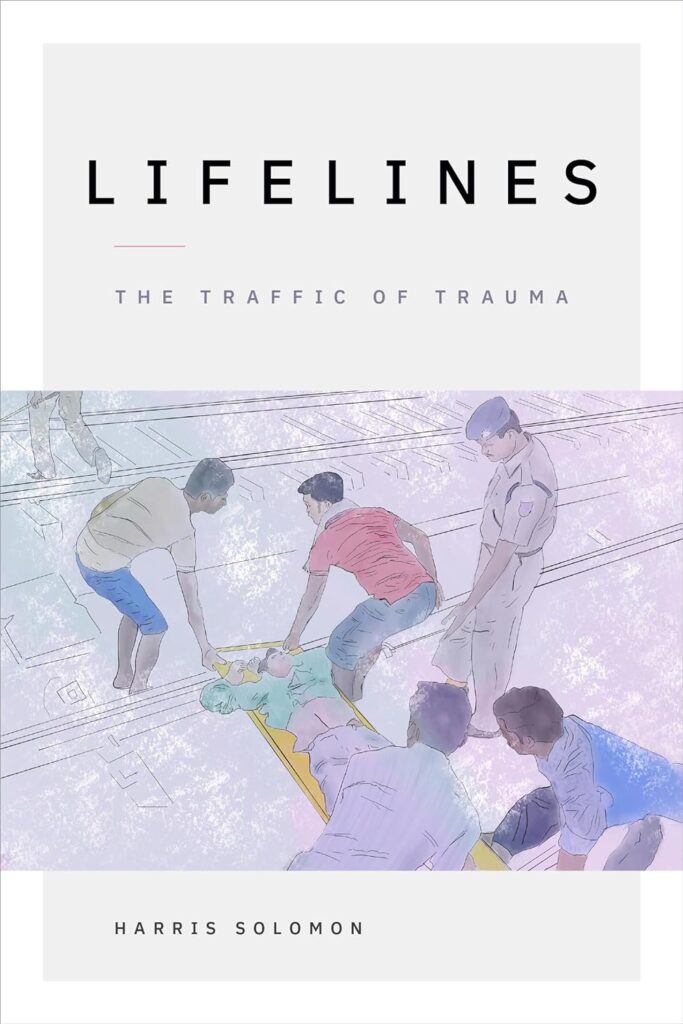Reviewed Book
Lifelines: The Traffic of Trauma By Harris Solomon, Durham, NC: Duke University Press. 2022. pp. 304.

Ieva Jusionyte
Brown University
What happens after a traffic accident? How does life-threatening interruption of movement, such as during a vehicle collision, set in motion other mobilities that enable the injured to survive? Medical anthropologist Harris Solomon poses these questions in his new book Lifelines: The Traffic of Trauma, which he describes as “an ethnography of mobility and mortality.” Deftly weaving medical anthropology with urban anthropology, Solomon offers a close look inside a major public hospital trauma ward in Mumbai, India, where injury is not an interruption of life but an ordinary part of it. But Lifelines is much more than a hospital ethnography. Solomon invites us to think about vital and lethal connections that underlie modernity from the vantage point of a city in the Global South.
The book traces the threads that start with the vectors of injury (trains, automobiles, motorcycles) that interrupt bodies in motion and moves on to modes of transport through which those injured bodies reach the hospital and then to the choreography of care inside the emergency room and the intensive care unit (ICU), where orderlies move patients from stretchers to operating rooms and where doctors and nurses help move air into their lungs, all the way to discharge and uneven routes to recovery. The chapter titles—“Carrying,” “Shifting,” “Dissecting”—can be read as nouns or as verbs, suggesting that the links in the chain of survival are themselves made up of various motions. Lifelines, as Solomon writes, “are patterned and relational movements that might remedy life-and-death situations” (6). By drawing our attention to traffic, the book reveals how the unevenness of movement, which is related to social inequality, results in trauma and how its different modalities determine its outcomes. Universal standards of trauma care, developed in the Global North, don’t account for the friction of traffic that characterizes urban life in the Global South.
Medical anthropologists have done a lot of important work showing how illness and healing are social and not merely biological processes, and Solomon extends this line of argument to traumatic injury. Even though wounds damage individual bodies, trauma is social and relational. Injuries happen because of “kinetic violence,” which can be tied to structural violence, such as when a boy falls onto an iron rod submerged under water at a construction site (69−70). Who is to blame for his injury? The ambulance, too, conveys social inequality, as the injured are rushed to private or public hospitals. Trauma activates relationships: when resources are scarce, a patient’s relatives, moving between home and hospital, provide essential labor. In the break room during a night shift, with a monsoon lashing the roof, the staff share chicken curry and boiled eggs and talk more openly about their family lives and about caste difference (97). In a deeply personal chapter, “Seeing,” which is a beautiful and powerful meditation on what happens when an ethnographer goes from being the observer in the operating theater to the observed, Solomon recounts his own experience of having brain surgery and concludes that “a craniotomy and tumor resection (with others) is a different surgery than a craniotomy and tumor resection (alone)” (139).
But Solomon takes this argument about lifelines as patterned and relational movements even further by showing us that such essential bodily functions as breathing are also social. Reading this during the COVID-19 pandemic (which is discussed in the epilogue) may be less surprising, but the point deserves underscoring. Moving air into the lungs when an injured patient cannot breathe requires someone to squeeze an Ambu bag, to adjust the settings on the ventilator. In an ICU, where a man named Anand spent 80 days hooked up to a machine that pushed air down a plastic tube lodged in his trachea, we see that breathing is indisputably a social technique. But that’s not all. There is also the unhealthy air quality index in Mumbai, the air-conditioning turned on in some parts of the hospital but not others, the mold in the ceiling corners, the fumes of insecticide that look like smoke from a fire. While patients hooked up to ventilators who survive because of social relations—because of kin and medical professionals who press air into their lungs to circulate oxygen to their blood cells—are the most literal cases of social breathing, Solomon shows us that, to a large degree, all breathing is a social activity.
As an ethnography of traumatic injury, Lifelines is honest about its scope and limitations. In a short section on “Methods and Writing,” Solomon explains that his research ethic was that of “measured refrain” (24). To avoid being “a burden” (35), he does not ride in the ambulances with injured patients, so most of his fieldwork happens in the trauma ward, where, with approvals from several institutional review boards, Solomon follows doctors and nurses but also X-ray technicians and orderlies, observing surgeries and autopsies and spending downtime with the staff drinking tea and viewing videos of gruesome accidents. Although some theoretical discussion about “injury’s relational kinetics” may be best suited for an advanced graduate seminar, the book provides insightful analysis of social dynamics at the trauma ward and, as such, will appeal broadly to students in medical anthropology, medical humanities, public and global health, and medical school. Written in an engaging, accessible style, full of rich descriptions of mundane moments that make up the hospital routine, where surgeons listen to Bollywood music as they operate on patients and where pathologists engage in dark humor during lunch following an autopsy—details that have stayed with me long after I put down the book—it has something to offer to anyone who has ever stepped through the hospital door.